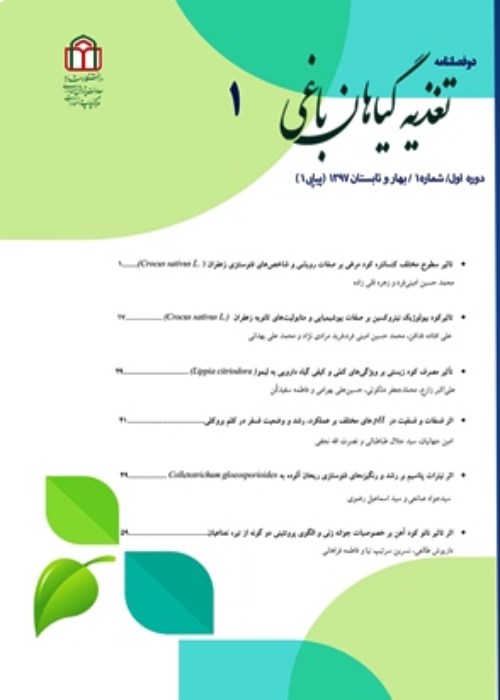The effect of different amounts of nitrogen fertilizer and poultry manure on yield and nitrate concentration in autumn potato crop in Jiroft region
Due to the fact that it is not possible to remove chemical fertilizers in agriculture at once and also the use of organic fertilizers alone cannot fully complete the nutritional needs of plants, especially annuals plants, so the use of organic fertilizers with optimal use of Chemical fertilizers can play an important role in maintaining the physical and chemical structure of soil, increasing crop yield and reducing the negative environmental effects of chemical fertilizers. In the southern region of Kerman province, potatoes have been cultivated in autumn and winter for more than a decade. According to the studies on the amount and type of fertilizers used in autumn cultivation in the region, it seems that there is excessive consumption of fertilizers, especially urea, which, while producing a problematic crop, has destroyed soil fertility and polluted groundwater. One of the effective actions to reduce or stop this wrong process is the optimal use of chemical fertilizers and the use of organic fertilizers. This study was conducted to evaluate the application of poultry manure and urea fertilizer in potato production in the south of Kerman province.
The experiment was conducted in a randomized complete block design with five treatments, in three replications and for two years in Jiroft. The research treatments were: 1- Control (as in the region), 2- Recommended optimal urea limit for the region crop + Optimal consumption of other nutrients based on soil test, 3- Urea consumption 25% more than the optimal limit + Optimal consumption of other nutrients based on soil test, 4- Consumption of urea 25% less than the optimal limit + five tons of poultry manure per hectare + optimal consumption of other nutrients based on soil test and 5- Consumption of urea 25% less than the optimal limit + ten tons of poultry manure per hectare + Optimal consumption of other nutrients based on soil test. At the end of each year, the performance of each treatment was measured. Also, random samples were prepared from the tubers and leaves of each plot and potassium, iron, zinc, manganese and nitrate were measured in the tubers and leaves.
The results showed that the control treatment had the lowest yield (20 t / ha) and the highest nitrate concentration (293.3 and 639.5 mg/kg dry matter, respectively) and the lowest concentrations of potassium, iron, zinc and manganese in tubers and leaves. While treatment number five had the highest yield, which shows an increase of 74% compared to the control. Treatment number four had the lowest amount of nitrate, which had 48.8%, 14.6, 32.3 and 13.8% less nitrate in the tuber than treatments one, two, three and five, respectively.
The results showed that the application of treatment number five caused the production of about 35 tons per hectare and reduced the concentration of nitrate in the tuber (30% less than the critical level in Iran). Also, in terms of economic importance, the application of the recommended treatment, while reducing the consumption of urea fertilizer by 50% and increasing production by 75%, resulted in an income of about 50% more than the control treatment.
-
Integrated Management as a Sustainable Strategy to Control of Citrus Decline
J Sarhadi, S. Heidari*, M. Sharif
Journal of Crop production and processing, -
Modeling the relationship between iron concentration in citrus leaves and some soil properties using artificial neural network (case study of southern Kerman province)
Saber Heidari *, Seyed Ali Ghaffari Nejad, , Mehri Sharif
Iranian Journal of Soil and Water Research,


